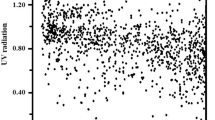Abstract
The influence of various cloud parameters and the interactions with the ground albedo and the solar zenith angle have been studied by means of model simulations. The radiative transfer model suitable for a cloudy atmosphere as well as for a clear atmosphere has been developed on the basis of the Discrete Ordinate Method. This study leads to a general understanding for cloudy atmospheres: in the presence of a uniform cloud, the cloud scattering is dominant to molecular and aerosol scattering, and it is also wavelength-independent; the ratio of transmitted irradiance in a cloudy atmosphere to that in the background clear atmosphere is independent of cloud height and solar zenith angle. That’s to say. the radiation downwelling out of a cloud is quite isotropic; it decreases approximately exponentially with the cloud optical depth at a rate related to the ground albedo; the reflected irradiance at the top of the atmosphere is dependent on cloud optical depth as well as on solar zenith angle, but not on ground albedo for clouds of not very thin optical depth.
Similar content being viewed by others
References
Deirmendjian, D. (1969),Electromagnetic Scattering on Spherical Polydispersions, American Elsevier Publishing Co. Inc., New York.
Falcone, V. J., W. A. Leonard and E. P. Shettle (1979), Atmospheric attenuation of millimeter and submillimeter waves: Models and computer code, AFGL-TR-0253.
Farman, J. C, B. G. Gardiner, and J. D. Shanklin (1985), Large losses of total ozone in Antarctica reveal seasonal CLOx/ NOx interaction,Nature. 315: 207–210.
Gardiner, B. G., and P. J. Kirsch (1992), European Intercomparison of Ultraviolet Spectrometers, Panorama, Greece, 3-12 July, 1991,Air Pollution Research Report 38, Commission of the European Communities, Directorate-General for Science, Research and Development, Brussels, 70pp.
Hale, G. and M. Querry (1973), Optical constants of water in the 200 nm to 200 μm wavelength region,Appl. Opt.,12: 555–563.
Kneizys, F. X., G. P. Anderson, E. P. Shettle, W. O. Gallery, L. W. Abreu, J. E. A. Selby, J. H. Chetwynd, S. A. Clough (1988), User’s guide to LOWTRAN 7, AFGL-TR-88-0177.
Lubin, D. and J. E. Frederick (1991), The ultraviolet radiation environment of the Antarctic peninsula: the role of the ozone and cloud cover,J. Appl. Meteor.,30: 478–493.
NASA (1966),U. S. standard atmosphere supplements, 1966, U. S. Government Printing Office, Washington, D. C.
NASA (1976),U. S. standard atmosphere supplements, 1976, U. S. Government Printing Office, Washington, D. C
Silverman, B. A. and Sprague, E. D. (1970), Airborne measurements of in-cloud visibility, National Conference on Weather Modification of the American Meteorological Society, April 6-9, Santa Barbara, California.
Stamnes, K., S. C. Tsay, W. J. Wiscombe and K. Jayaweera (1988), Numerically stable algorithm for discrete-ordinate-method radiative transfer in multiple scattering and emitting layered media,Appl. Opt.,27: 2502–2509.
Stolarski, R. S., P. Bloomfield, R. D. McPeter, J. R. Herman (1991), Total ozone trends deduced from Nimbus 7 TOMS data,Geophys. Res. Lett.,18: 1015–1018.
Tsay, S. C. and K. Stamnes (1992), Ultraviolet radiation in the Arctic: the impact of potential ozone depiction and cloud effects,J. Geophys. Res. 97: 7829–7840.
Wang P. C. and J. Lenoble (1994), Comparison between measurements and modeling of UV-B irradiance for clear sky: a case study,Appl. Opt.,33: 3964–3971.
Author information
Authors and Affiliations
Additional information
This work has been supported by the Commission of European Communities (Contract No. STEP0076). The authors are indebted to K. Stamnes and his colleagues for providing a DOM radiation code.




